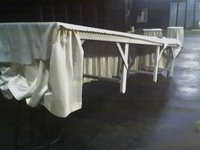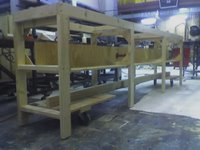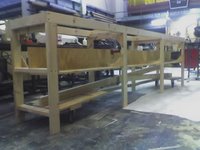I thought perhaps I had an article in the making here, so you - fair readers - will be subject to my outlining. Either that or it might just be my version of Friday Show & Tell...
With all the high tech apparatus currently being coveted by entertainment programs around the nation it is sometimes easy to forget that many problems can be solved by decidedly low tech approaches. In fact, there are several recurring challenges in theatre that cry out for easy, kind of "dare to be stupid" solutions. Things like a door in a drop, a low profile wagon, a tall rolling thing that doesn't fall over are all issues that never go away and are never once and for all solved.
I believe that the continued purpose built solution is one of the coolest things about theatrical technical direction.
Another frequent poser that could be added to the list above is: rolling thing that doesn't roll when its not supposed to. The band-aid solutions to this are usually wedges stuck under the edge, or door stops on the sides, maybe locking casters, or sometimes cane-bolts into holes in the floor. Most of these work with varying degrees of success. It is possible though to have a much more successful solution to the problem if the device is designed into the fabrication of the piece.
A recent project at CMU provided three opportunities to solve this problem in three different ways in one 24 hour period. The different approaches each have advantages and disadvantages, but are all viable, and on the whole are very simple.
The first solution came right off the designer's elevation. For this table piece we were instructed to caster one end of the unit. Wheels on one end, plus doctoring the legs on that end produce a unit that can be lifted like a wheel barrow and pushed on or off stage. The solution uses rigid casters, but since it is only wheeled on one end, the piece may be steered easily. When the unwheeled end is placed on the ground, the unit sits flat and doesn't move.


This was a good solution in this case as the unit travels only out of sight, and because actors will be crawling underneath as part of the stage action; so it was necessary to keep the area underneath as clear as possible.
The second approach uses a few moving parts, but is also fairly simple. This is a fairly classic lift-jack. The wheels for the unit are mounted on pivoting plates. Each plate is connected to a lever, and the levers are situated such that one also moves the other. Push the levers down, the plates rock to level pushing the wheels down, and the unit sits up on the wheels to roll away. This particular application utilizes an additional arm with a handle to facilitate operation and locking.

This was good for this application because there was a good deal of available real-estate within the piece for the mechanism. The shift wants to happen a-vista, so this should be reasonably magical. Also the piece only has to carry its own weight.
The third iteration is a little more complex. This approach utilizes moving parts, some actuators, and a stored power supply - compressed air. In this solution, the casters are mounted to a free floating plate contained within the base of the unit. Above the moving plate is a fixed plate, and on that plate there are multiple pneumatic cylinders. A valve is placed between the air supply and the actuators. Apply the air and open the valve, the cylinders extend pushing the unit against the wheels and raising the piece off the floor - free to roll. Remove the air supply and open the valve and the unit sits back on the floor.

In this case, the shift is happening behind an act curtain during an intermission, so the air supply will likely be a hose to the building compressor system. However, had this been a change in view of the audience it would not be complicated to add an onboard air tank.
This is a good solution for this piece because there is very limited space available. This also works well because this unit actually is a doorway arch, so there are two bases that must lift and there is no way to mechanically link them. Snaking a hose through the header frame to power a second set of cylinders is comparatively simple.
So, three solutions, no wedges, no holes in the deck, no electronics or programming. Just simple machines and a little forethought for three clean solutions.
Friday, January 06, 2006
There's More Than One Way to Skin a Cat
Posted by
David
at
11:48 PM
![]()
Subscribe to:
Post Comments (Atom)


4 comments:
Dare I ask:
What types of electronics & programming would come to mind to help solve this?
Wireless triggering of the pneumatics in the 3rd solution? Or were you referring to a full automation solution?
Suppose the problem was just enough trickier (live placement of the unit with an actor for instance), how easy/cheap would the electronics & control need to be?
I just mean to say that something can be interesting and challenging without bells and whistles.
I know NOTHING about your line of work, but feel like I just learned a whole LOT! Good job Prof!!
Haha... ok, yes, of course I agree.
I was hoping you'd bite and comment on the very different issue of electronics and control as a possible solution for certain problems.
Nice post!
Post a Comment